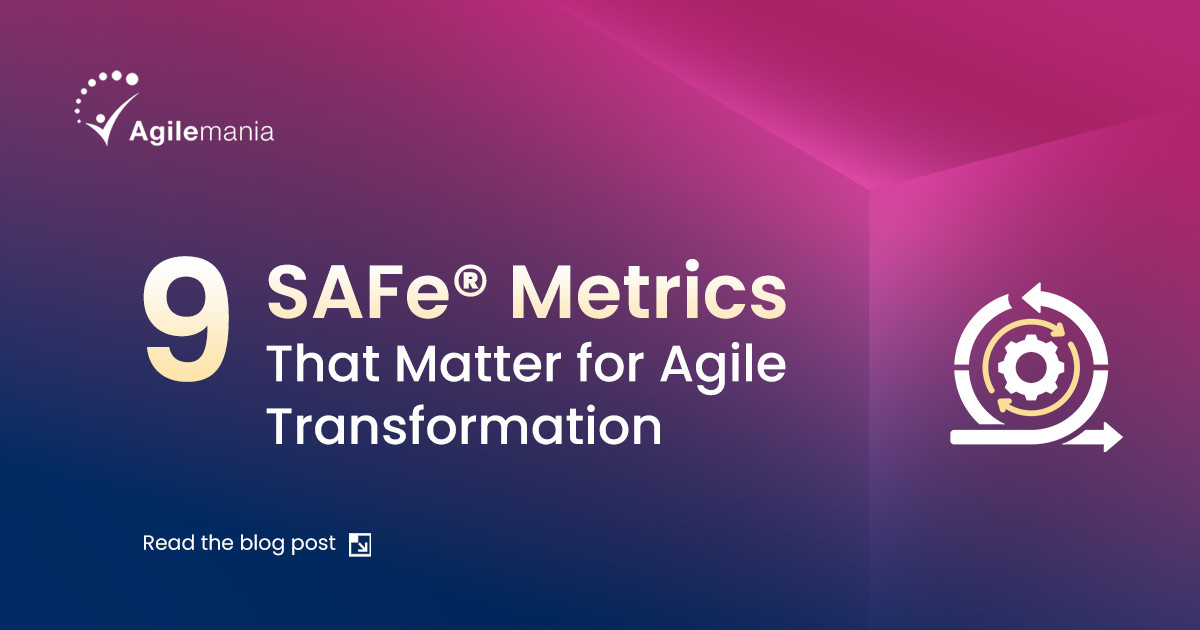
Agilemania
Agilemania, a small group of passionate Lean-Agile-DevOps consultants and trainers, is the most tru... Read more
![]() Get Your AI-Enabled Scrum Master Certification for Just ₹2,500 (Save 75%)!
Get Your AI-Enabled Scrum Master Certification for Just ₹2,500 (Save 75%)!
Scrum.Org
SAFe®
ICAgile
Scrum Alliance
Technical Agility
Kanban
Business Analysis
Project Management
AI-Enabled
Agilemania Academy
Scrum.Org
SAFe®
ICAgile
Scrum Alliance
Technical Agility
Kanban
Business Analysis
Project Management
AI-Enabled

Agilemania
Agilemania, a small group of passionate Lean-Agile-DevOps consultants and trainers, is the most tru... Read more

SAFe metrics are pivotal in assessing and advancing Business Agility within enterprises. They serve as a compass guiding leaders, teams, and stakeholders toward responsive, innovative solutions to emerging business challenges. This approach, known as Measure and Grow, underpins the ethos of SAFe by facilitating a structured evaluation of organizational performance and identification of improvement opportunities.
Business Agility, heralding a paradigm shift in organizational performance, necessitates swift responses to market dynamics and the advent of new opportunities through digitally-driven solutions. To navigate this landscape effectively, organizations rely on a robust framework of metrics, structured around three core domains: Outcomes, Flow, and Competency.
Outcomes: This domain evaluates the efficacy of solutions in meeting customer and business needs. It focuses on the tangible impact of products or services delivered to the market, ensuring alignment with strategic objectives and customer satisfaction.
Flow: Assessing the efficiency of value delivery mechanisms, the Flow domain scrutinizes the organization's ability to swiftly and effectively deliver value to customers. It encompasses metrics related to throughput, lead time, and workflow optimization, enabling organizations to streamline processes and enhance delivery speed.
Competency: Central to enabling Business Agility, the Competency domain gauges the organization's proficiency in adopting Lean-Agile practices and fostering a culture of continuous improvement. It encompasses assessments of leadership capabilities, technical excellence, and the organization's capacity for learning and adaptation.
These three measurement domains provide a comprehensive framework for evaluating organizational performance and guiding improvement initiatives. By leveraging insights gleaned from these metrics, organizations can make informed decisions, identify areas for enhancement, and chart a course toward sustained Business Agility.
Enhance Your SAFe Exam Readiness with Comprehensive Assessment Questions Tailored for Success. Elevate Your Understanding and Confidence with Targeted Practice, Paving the Way for High Scores and Certification Achievement.
Take the Test!
What it Measures: Flow velocity measures the rate at which work items move through the value stream, typically expressed as the number of stories, features, or capabilities delivered per iteration or Program Increment (PI).
How to Measure: Flow velocity is calculated by counting the number of completed work items within a specific time frame, such as an iteration or PI.
Why it's Important: Flow velocity provides insights into the efficiency of the development process and helps identify bottlenecks impacting delivery speed. By tracking velocity trends over time, teams can optimize their workflow, improve productivity, and ensure timely delivery of valuable outcomes to customers.
What it Measures: Flow time represents the duration it takes for a work item to progress from conception to deployment in production, encompassing all stages of the development process.
How to Measure: Flow time is measured by calculating the total elapsed time for completing a work item, from its initiation to deployment.
Why it's Important: Flow time directly impacts time-to-market and customer satisfaction. Shorter flow times enable organizations to respond quickly to market demands, reduce the risk of obsolescence, and increase competitiveness. By minimizing flow time, teams can accelerate delivery cycles and deliver value to customers more rapidly.
What it Measures: Flow load indicates the amount of work currently in progress within the value stream, providing insights into capacity utilization and workload distribution.
How to Measure: Flow load is visualized through Cumulative Flow Diagrams (CFDs), which depict the quantity of work in different stages of the workflow over time.
Why it's Important: Managing flow load is essential for maintaining a balanced and efficient workflow. By limiting work in progress (WIP), teams can prevent overburdening, reduce lead times, and optimize flow efficiency. Monitoring flow load helps teams identify capacity constraints, prioritize work, and ensure smooth value delivery.
What it Measures: Flow efficiency measures the ratio of value-adding time to total lead time within the workflow, indicating the proportion of time spent on productive activities versus waiting or non-value-adding tasks.
How to Measure: Flow efficiency is calculated by dividing the total active time by the total lead time and expressing it as a percentage.
Why it's Important: Flow efficiency is a key indicator of process effectiveness and productivity. Higher flow efficiency results in faster delivery, reduced cycle times, and increased customer satisfaction. By identifying and eliminating bottlenecks and waste, organizations can optimize flow efficiency and improve overall performance.
What it Measures: Flow predictability assesses the reliability of teams in delivering against their planned program objectives, measuring the alignment between planned and actual delivery outcomes.
How to Measure: Flow predictability is measured using the ART Predictability Measure, which calculates the ratio of actual business value delivered in a PI to the planned business value.
Why it's Important: Predictable flow enables stakeholders to trust delivery commitments and make informed decisions based on accurate projections of delivery timelines and outcomes. By improving flow predictability, organizations can enhance planning accuracy, mitigate risks, and ensure successful delivery of strategic initiatives.
What it Measures: Objectives and Key Results (OKRs) quantify portfolio-level strategic goals, while Key Performance Indicators (KPIs) measure outcomes for specific value streams or initiatives.
How to Measure: OKRs define clear targets and priorities aligned with strategic objectives, while KPIs provide measurable indicators of performance, such as revenue growth, customer satisfaction, or product quality.
Why it's Important: OKRs and KPIs enable organizations to align their efforts with strategic priorities, monitor progress towards goals, and drive accountability. By defining clear objectives and measuring outcomes, teams can focus on delivering value, track their impact on business results, and continuously improve their performance.
If you're not yet an SAFe® Community Member, you can gain access by taking any SAFe® course. Completing a SAFe® course will give you full access to the member site.
Register Today!
What it Measures: Quality metrics assess various aspects of product quality, including defects leaked, test coverage, and technical debt.
How to Measure: Quality metrics are tracked through tools and processes that capture data on defects, test coverage, code complexity, and other quality-related factors.
Why it's Important: Monitoring quality metrics helps organizations ensure that their products meet high standards of reliability, performance, and user satisfaction. By detecting and addressing quality issues early in the development process, teams can reduce rework, enhance customer experience, and deliver value with greater confidence.
What it Measures: Agile Release Trains (ARTs) are evaluated based on performance metrics such as burn-up/down charts, program predictability, and value delivered.
How to Measure: Performance metrics for ARTs are tracked and visualized through charts and dashboards that provide insights into progress, predictability, and value delivery.
Why it's Important: Assessing ART performance helps organizations ensure alignment with strategic objectives, identify areas for improvement, and optimize value delivery. By monitoring key metrics, such as burn-up/down charts and program predictability, teams can track progress, make data-driven decisions, and continuously improve their performance.
What it Measures: Competency assessments evaluate the proficiency of individuals, teams, and organizations across the seven core competencies essential for business agility.
How to Measure: Competency assessments involve evaluating skills, knowledge, and behaviors related to Lean-Agile practices, leadership, and continuous improvement.
Why it's Important: Measuring competency helps organizations identify strengths, weaknesses, and opportunities for improvement in key areas such as Lean-Agile leadership, technical excellence, and continuous learning. By investing in competency development, organizations can build the capabilities necessary to drive successful Agile transformations and achieve sustainable business agility.
Overall, these nine metrics provide a holistic framework for measuring and improving Agile transformation in organizations adopting the SAFe® methodology. By focusing on outcomes, flow, and competency, organizations can foster a culture of continuous improvement, adaptability, and customer-centricity, enabling them to achieve sustainable business agility and competitive advantage.
SAFe® metrics are a set of measurements used to evaluate and enhance Business Agility in enterprises. They are crucial because they provide insights into the efficiency and effectiveness of Agile practices, helping organizations identify areas for improvement, optimize workflows, and ensure alignment with strategic goals. By leveraging these metrics, teams can make informed decisions, improve productivity, and deliver higher value to customers.
Team metrics in SAFe typically include Flow Velocity, Flow Time, Flow Efficiency, and Quality Metrics. These metrics help teams track their performance, identify bottlenecks, improve processes, and ensure high-quality delivery.
In SAFe Agile, a Key Performance Indicator (KPI) is a measurable value that indicates how effectively a team or organization is achieving key business objectives. KPIs are used to track performance outcomes for specific value streams or initiatives, such as revenue growth, customer satisfaction, and product quality.
Flow Velocity measures the rate at which work items move through the value stream, indicating the number of stories, features, or capabilities delivered per iteration or Program Increment (PI). It is essential for Agile transformation as it provides insights into the efficiency of the development process, identifies bottlenecks, and helps teams optimize their workflow. By tracking Flow Velocity, organizations can enhance productivity and ensure the timely delivery of valuable outcomes to customers.
Flow Time represents the total duration it takes for a work item to progress from conception to deployment, encompassing all stages of the development process. It impacts time-to-market and customer satisfaction, with shorter Flow Times enabling quicker responses to market demands.
Flow Efficiency, on the other hand, measures the ratio of value-adding time to total lead time within the workflow. It indicates the proportion of time spent on productive activities versus waiting or non-value-adding tasks. Higher Flow Efficiency results in faster delivery and reduced cycle times. By improving Flow Efficiency, organizations can optimize processes, reduce waste, and enhance overall performance.
Agilemania, a small group of passionate Lean-Agile-DevOps consultants and trainers, is the most trusted brand for digital transformations in South and South-East Asia.
WhatsApp Us
We will get back to you soon!
For a detailed enquiry, please write to us at connect@agilemania.com

